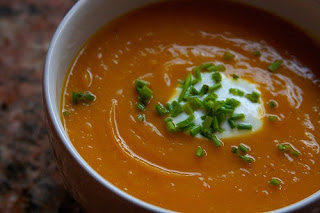Butternut squash is a great seasonal alternative to Pumpkin this Fall and Winter. Butternut squash is loaded with nutritional benefits and full of preventional properties that help fight cancer.
Butternut squash is from the gourd family or part of the Cucurbitaceae family that includes the cucumber, melon, and pumpkins. Butternut squash is a winter squash and can be harvested in late fall and early winter. Members of the fall and winter squash family are Butternut squash, Hubbard, Pumpkins, Turban, and Acorn squash. There are many different types of squash from size, shape, color, and flavor. All winter squash have a thick skins, varied shapes, and colors from dark green, orange-yellow, grey-blue, cream-colored and orange-red with speckled patches of yellow-orange. Butternut squash is shaped like an elongated pear with cream colored skin and sweet tasting flesh on the inside.
Butternut squash, like most winter squash, have a very high nutritional value. Butternut squash in particular has a long history spanning back over 7000 years ago from native Indians living in the Western Hemisphere who cultivated and were eating this tasty and very beneficial squash. What are the health benefits of eating Butternut squash? During this autumn season instead of cooking with pumpkin, which will be on the menu throughout this holiday season, why not switch it up a bit and try reaping the rewards of this other flavorful squash. Butternut squash is rich in beta carotene, high in fiber, vitamin C, calcium, iron, and potassium.
Butternut squash has some powerful anti-cancer properties that are beneficial to the body. Science and research are just beginning to catch up with the health benefits of eating this particular squash. The beta-carotene found in Butternut squash gives a powerful nutritional value of vitamin A that can help reduce your risk of certain cancers like leukemia, may also help with BPH or benign prostatic hypertrophy, vision problems, and developing skin disorders. Butternut squash also has potent anti-inflammatory and antioxidant properties that prevent oxidization of cholesterol within the body which can help lower weight gain. Butternut squash is high in fiber and potassium that are beneficial in the prevention of high blood pressure and heart disease. Butternut squash is rich in folate, and has very low calories making this incredible autumn vegetable very healthy and beneficial to eat.
Butternut squash is available in early Autumn through Winter and can be found in most grocery stores and local food markets. Butternut squash has a sweet tasting orange flesh and can be a nice change of pace from regular pumpkin recipes. Try your hand at making new dishes with Butternut squash in soups, salads, stew, and pies. Butternut squash makes a great complement for this Fall season’s cooking recipes, and it makes a great alternative for a healthy diet too. For a list of 100 recipes on Butternut squash visit the Foodnetwork or Allrecipes or go to these links:
http://www.foodnetwork.com/topics/butternut-squash/index.html or http://allrecipes.com/recipes/fruits-and-vegetables/vegetables-n-z/squash/winter-squash/butternut-squash/main.aspx
Try reading:
Pumpkin, Butternut and Squash: 30 Sweet and Savoury Recipes
T.S.Garp © Copyright 2010 All Rights Reserved.




























0 comments:
Post a Comment